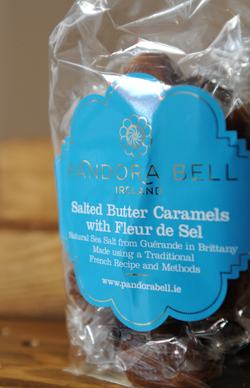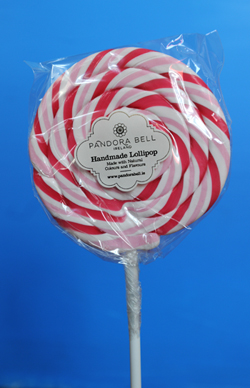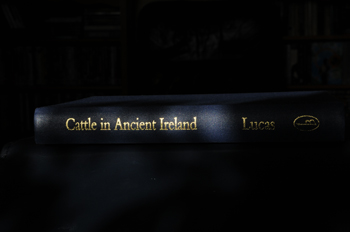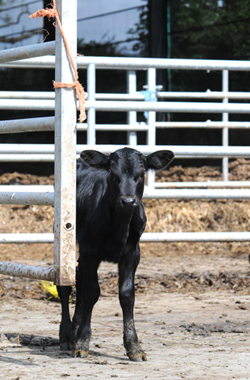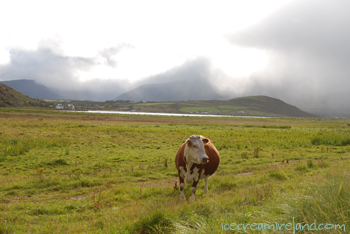If the Lord delight in us, then He will bring us into this land and give it to us, a land which floweth with milk and honey. – Numbers, 14:8
In the townland of Tobar na Múdán, just outside Dingle, darkness envelopes everything. Hidden is the view from the reeds and waters of the Short Strand to the dramatic heights of Sliabh Mhacha Ré, for the only light filters out the door of Colm Murphy’s milking parlour. With their black coats, his little Kerry cows are invisible in the yard, and the white markings of the larger Friesians appear as disembodied splotches. It’s early – birds haven’t yet found their voice, and the profound silence outside is hardly disturbed by the gentle shifting feet of the cattle, the soft rhythm of their breathing, and the muted “chuck, chuck, chuck” of the milking machine.
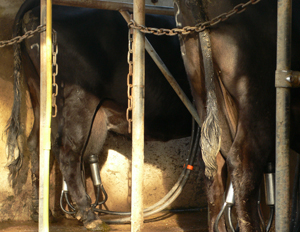 Colm shows me how it’s done – how to open the gate to let in the cattle, how to tie the safety chain behind them once they clamber onto the milking platform, and how to attach the cups to the udders. He has the easy, economical movements of someone with years experience and is gracious enough not to mind me slowing things down. The cows, more interested in their morning treat, don’t take much notice of my fumblings. Milk starts flowing into the tank, and Colm tells me about each cow – this one lost a calf, this one is quite old, and this one might kick if you’re not careful. Soon enough the cows are dry, and we release them to make room for the next batch.
Colm shows me how it’s done – how to open the gate to let in the cattle, how to tie the safety chain behind them once they clamber onto the milking platform, and how to attach the cups to the udders. He has the easy, economical movements of someone with years experience and is gracious enough not to mind me slowing things down. The cows, more interested in their morning treat, don’t take much notice of my fumblings. Milk starts flowing into the tank, and Colm tells me about each cow – this one lost a calf, this one is quite old, and this one might kick if you’re not careful. Soon enough the cows are dry, and we release them to make room for the next batch.
There is nothing glamourous about milking, especially on a dark, damp, cold morning. However, it’s deeply comforting. Perhaps it’s being surrounded by such large and gentle beasts. Perhaps it’s the rhythm of it. Perhaps it’s that we’ve been milking for thousands of years and the process feels timeless. For cows are intertwined with Ireland’s history. We can see it in our place names – “Múdán” in Colm’s townland refers to the inside of a cow’s horn. We can find a cow in Drumshambo, Ardboe, Inishbofin, Lough Bo, and Boyne (from Bóinne, Boann, or Bovinda – the goddess of the white cow). The road that might take you to those places, “bóthar,” is defined in width by the length and breadth of a cow.
Our legendary epic, the Táin Bó Cúailinge (about a cattle raid), is a part of Lebor na hUidre, the Book of the Dun Cow, the oldest extant Irish manuscript. We can go back further, however. Old Croghan Man’s last meal included buttermilk (and milk might have caused his death – a possible ritual sacrifice to ensure the supply of milk and corn to his people). We can go back further still, since scientists radio carbon-dated a cow bone found in a dig at Ferriter’s Cove in Kerry to 4500 BC. Considering that humans probably consumed their first cow milk in the Near East between 5,000 and 7,000 BC, when they developed the enzyme needed to digest it, it seems us Irish were early adopters when it came to this new food source.
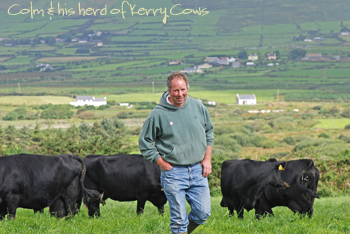
And adopt it we did. Cows featured in Irish society, from birth to death. As a newborn, St. Brigid (known as ”Brigid of the Kine” – cows) was bathed in milk, as would have been usual; only the poor bathed their babies in water. Boys tended the cows (our Irish word for boy, “buachaill,” comes from “cowherd”), and women milked them. Cows made up all or part of a bride price, poets charged for their work in cows, cows were guarded jealously and raided mercilessly, and when chieftains fell in battle (often on a “creach” or cattle raid), their cows joined the mourners following the coffin to its final resting place. The Annals of Ulster, along with other references, speak of a tradition of calves taken away from their mothers upon a death, so that their hungry cries amplified the keening mourners.
Professor A. T. Lucas, in his book Cattle in Ancient Ireland, says, “It must be emphasized that these thousands of allusions (in Irish manuscripts) are not to cattle in general but specifically to cows and more specifically to cows as yielders of milk. There are no beef-eating heroes in Irish literature; the doughtiest Irish warriors relied on pig-meat for their intake of protein.” Milk provided food, and it also provided strength. In 1596, Sir George Carew reported back to England that the Irish were too powerful in the summertime, when they lived “upon the milk and butter of their kine,” and recommended that would-be invaders wait until the milk-less winter months to attack.
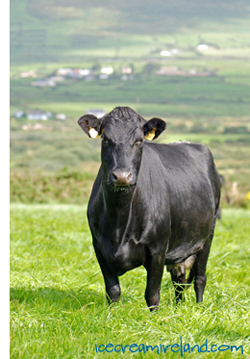 So, how is it that the milk cow, once the highest unit of currency under Brehon law, has little value these days? According to local folklorist T. P. O’Conchuir, the Dingle creamery paid farmers the equivalent of 15c a gallon in the 1960’s. A gallon of milk sold in the shop, ladled out in pint measures with a splash thrown in for the cat, was 30c. A pint of Guinness was 15c, and pints have kept a fairly constant ratio to wages over time. By that measure, we now pay around half what we once did for milk, and farmers receive a quarter. Why? I can’t believe it’s about quality, since I have never tasted milk as good as we have here in Ireland. It seems, like many Irish foods, that milk has become a commodity, something taken for granted.
So, how is it that the milk cow, once the highest unit of currency under Brehon law, has little value these days? According to local folklorist T. P. O’Conchuir, the Dingle creamery paid farmers the equivalent of 15c a gallon in the 1960’s. A gallon of milk sold in the shop, ladled out in pint measures with a splash thrown in for the cat, was 30c. A pint of Guinness was 15c, and pints have kept a fairly constant ratio to wages over time. By that measure, we now pay around half what we once did for milk, and farmers receive a quarter. Why? I can’t believe it’s about quality, since I have never tasted milk as good as we have here in Ireland. It seems, like many Irish foods, that milk has become a commodity, something taken for granted.
Perhaps one of the reasons is that for most people milk is no longer a local affair. It’s big business. According to the National Dairy Council, the domestic Irish dairy market is valued at €1 billion, and the foreign market is an additional €2.36 billion or 27% of our entire food and drink exports. This supports 22,000 farmers, who produce over 5 billion litres of milk annually. These are huge figures, but they wouldn’t impress many farmers. Their numbers have fallen from 68,000 in 1984, and more will leave their land now that milk prices have collapsed to unsustainable levels. Jackie Cahill of ICSMA points out that the average cost of producing a litre of milk is 23c, excluding labour, and that most processors pay out a similar figure, leaving farmers with no income whatsoever.
MEP Mairead McGuinness, who serves on the European Agriculture and Rural Development Committee, says farmers are facing the cold economic reality of global markets. European measures will help a bit to ease the current milk crisis, but she sees a future for only some Irish dairy famers, those who “get their cost base in order.” She does, however, point out that milk in Ireland is divided between the milk we drink at home and agribusiness products. We can work on adding value for the former, looking at organics and other niches, but the latter is simply about price. The question is, given the inherent disadvantages of being a small island with relatively small farms, can we compete on price at all? Or, with all the cost cutting, will we lose the very quality that makes Irish milk so special?
On a visit last year to Tokyo, I noticed a statue of a huge black and white cow in swanky Roppongi Hills. On closer inspection, it fronted the Motoyama Milk Bar, a cafe quite comfortable with its surroundings of extreme high fashion and Michelin star restaurants. Inside, you can drink a small glass of unhomogenised milk, from a traditional farm in Hokkaido, for €3.50, or you could sample their other dairy snacks. Japan is not unique; milk bars are popping up around Asia and beyond. A rockabilly version has opened in Berlin. In New York City, at the Momofuku Milk Bar in Greenwich Village, my brother recently handed over more than $10 for a glass of cornflake flavoured milk and a cookie. He also found Ronnybrook Farm’s cafe in the Meatpacking District, where you can buy a pint of milk to take away for $3.
While I don’t think milk bars are the answers to the woes of Irish dairy farmers, I do think it’s interesting that milk has such high value in some of the world’s trendiest urban centres. To me this means there are still opportunities for farmers, and since nine out of ten of them upgraded their facilities last year, investing on average a year’s income in their operations, there is clearly a huge will to survive. Some have focused on efficiency and others are looking at new ways to increase their incomes. Irish farmers have a long tradition of making cheese, and they are now also churning out clotted cream, buttermilk, ice cream (we have a veritable glut of ice cream makers at the moment) and many other milk-based foods. Some are even going back to the practise of selling milk themselves.
In Mullingar, Gerry and Mary Kelly bottle their own, and their Moon Shine Dairy milk took home the top prize at the 2009 National Organic Awards. They are also the reigning “New Cheese” champions at the British Cheese Awards. I drank their milk recently amidst the bustle of the Dublin Food Coop in the Liberties and found it surprisingly light and beautifully smooth. The Kellys decided on organic certification in 1999 as a way of adding value so that they could continue farming, and they started selling their own products in 2006. They use biodynamic methods, although they are not Demeter certified, and treat their Ayreshire herd with herb’s, homeopathy and flower essences. Mary has just a completed Level 1 Bach remedy course and hopes to be a trained practitioner for animals by the end of this year.
“It’s a bit demoralising to see a litre of water dearer than a litre of milk,” she said, when I asked her how the business was going, “but we are still here. One has to integrate and juggle sales, paperwork, trade events and parenting. I’m a great believer that when you still yourself, your inner voice has something to say. That helps great deal.”
Of course it wouldn’t make sense for every dairy farmer to start bottling milk. It would, however, make a lot of sense for farmers to start thinking about how they can work with their local dairies to add value. We as a nation need to think about how we can elevate the perception of Irish food, both at home and abroad, to reflect its excellence. Vincent Cleary of Glenisk Ltd., believes Ireland is uniquely positioned to be the natural home of good food in a global context and strongly advises all farmers to look at the organic option. He pays his farmers a top price for milk and says as long as farmers watch their inputs, manage their grassland, farm in as environmentally friendly a manner as possible and comply with legislation, the future for organic milk production is bright.
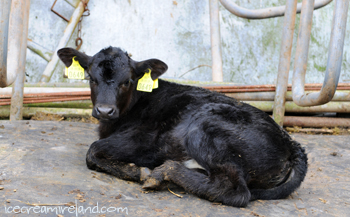 Back at Colm Murphy’s farm, we’re almost done with the milking. The sky has brightened, and the green fields and old stone walls take shape around us as we release the last few cows back into the yard and visit the new calves. One, a skinny creature with huge eyes, latches onto the end of the bottle of fresh, warm milk I’m holding, and suckles away. Colm, a bottle in each hand, manages two calves at once, and he says he loves being a part of the natural cycles of life; the microcosm that is his farm. He says he is a sex therapist, midwife, vet, bookkeeper, handyman, manager, driver, purchasing officer, and cook, depending on the time of year or the time of day. I’m relieved to hear the last, because I’m hungry and ready for breakfast. Colm has put aside a bucket of delicious, raw Irish milk. As soon as we’re done, we’ll drink it.
Back at Colm Murphy’s farm, we’re almost done with the milking. The sky has brightened, and the green fields and old stone walls take shape around us as we release the last few cows back into the yard and visit the new calves. One, a skinny creature with huge eyes, latches onto the end of the bottle of fresh, warm milk I’m holding, and suckles away. Colm, a bottle in each hand, manages two calves at once, and he says he loves being a part of the natural cycles of life; the microcosm that is his farm. He says he is a sex therapist, midwife, vet, bookkeeper, handyman, manager, driver, purchasing officer, and cook, depending on the time of year or the time of day. I’m relieved to hear the last, because I’m hungry and ready for breakfast. Colm has put aside a bucket of delicious, raw Irish milk. As soon as we’re done, we’ll drink it.
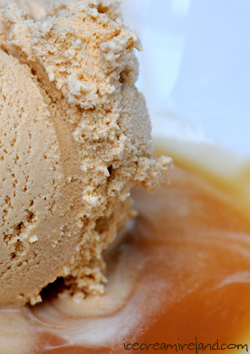 We’ve been working on a burnt (dark) caramel ice cream for our shops, trying it out on willing customers, and trying to improve it. It’s trickier than I would have thought, and I’m not satisfied with the result yet, even though it’s good and is selling quite well.
We’ve been working on a burnt (dark) caramel ice cream for our shops, trying it out on willing customers, and trying to improve it. It’s trickier than I would have thought, and I’m not satisfied with the result yet, even though it’s good and is selling quite well.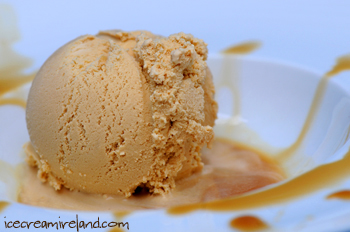 It’s both sweet and mysterious, simple and sophisticated. I want it darker, more intense, and we will be working on ways to make it more so.
It’s both sweet and mysterious, simple and sophisticated. I want it darker, more intense, and we will be working on ways to make it more so.











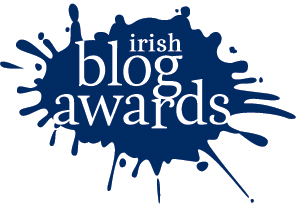 The
The 


 So, how is it that the milk cow, once the highest unit of currency under Brehon law, has little value these days? According to local folklorist T. P. O’Conchuir, the Dingle creamery paid farmers the equivalent of 15c a gallon in the 1960’s. A gallon of milk sold in the shop, ladled out in pint measures with a splash thrown in for the cat, was 30c. A pint of Guinness was 15c, and pints have kept a fairly constant ratio to wages over time. By that measure, we now pay around half what we once did for milk, and farmers receive a quarter. Why? I can’t believe it’s about quality, since I have never tasted milk as good as we have here in Ireland. It seems, like many Irish foods, that milk has become a commodity, something taken for granted.
So, how is it that the milk cow, once the highest unit of currency under Brehon law, has little value these days? According to local folklorist T. P. O’Conchuir, the Dingle creamery paid farmers the equivalent of 15c a gallon in the 1960’s. A gallon of milk sold in the shop, ladled out in pint measures with a splash thrown in for the cat, was 30c. A pint of Guinness was 15c, and pints have kept a fairly constant ratio to wages over time. By that measure, we now pay around half what we once did for milk, and farmers receive a quarter. Why? I can’t believe it’s about quality, since I have never tasted milk as good as we have here in Ireland. It seems, like many Irish foods, that milk has become a commodity, something taken for granted. Back at Colm Murphy’s farm, we’re almost done with the milking. The sky has brightened, and the green fields and old stone walls take shape around us as we release the last few cows back into the yard and visit the new calves. One, a skinny creature with huge eyes, latches onto the end of the bottle of fresh, warm milk I’m holding, and suckles away. Colm, a bottle in each hand, manages two calves at once, and he says he loves being a part of the natural cycles of life; the microcosm that is his farm. He says he is a sex therapist, midwife, vet, bookkeeper, handyman, manager, driver, purchasing officer, and cook, depending on the time of year or the time of day. I’m relieved to hear the last, because I’m hungry and ready for breakfast. Colm has put aside a bucket of delicious, raw Irish milk. As soon as we’re done, we’ll drink it.
Back at Colm Murphy’s farm, we’re almost done with the milking. The sky has brightened, and the green fields and old stone walls take shape around us as we release the last few cows back into the yard and visit the new calves. One, a skinny creature with huge eyes, latches onto the end of the bottle of fresh, warm milk I’m holding, and suckles away. Colm, a bottle in each hand, manages two calves at once, and he says he loves being a part of the natural cycles of life; the microcosm that is his farm. He says he is a sex therapist, midwife, vet, bookkeeper, handyman, manager, driver, purchasing officer, and cook, depending on the time of year or the time of day. I’m relieved to hear the last, because I’m hungry and ready for breakfast. Colm has put aside a bucket of delicious, raw Irish milk. As soon as we’re done, we’ll drink it.